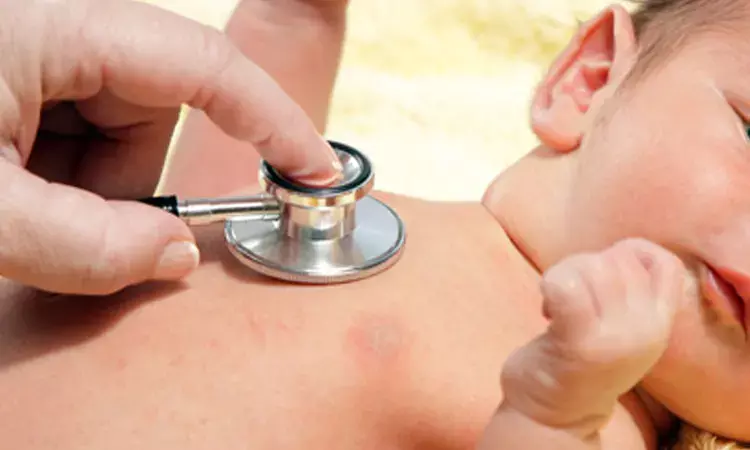- Home
- Medical news & Guidelines
- Anesthesiology
- Cardiology and CTVS
- Critical Care
- Dentistry
- Dermatology
- Diabetes and Endocrinology
- ENT
- Gastroenterology
- Medicine
- Nephrology
- Neurology
- Obstretics-Gynaecology
- Oncology
- Ophthalmology
- Orthopaedics
- Pediatrics-Neonatology
- Psychiatry
- Pulmonology
- Radiology
- Surgery
- Urology
- Laboratory Medicine
- Diet
- Nursing
- Paramedical
- Physiotherapy
- Health news
- Fact Check
- Bone Health Fact Check
- Brain Health Fact Check
- Cancer Related Fact Check
- Child Care Fact Check
- Dental and oral health fact check
- Diabetes and metabolic health fact check
- Diet and Nutrition Fact Check
- Eye and ENT Care Fact Check
- Fitness fact check
- Gut health fact check
- Heart health fact check
- Kidney health fact check
- Medical education fact check
- Men's health fact check
- Respiratory fact check
- Skin and hair care fact check
- Vaccine and Immunization fact check
- Women's health fact check
- AYUSH
- State News
- Andaman and Nicobar Islands
- Andhra Pradesh
- Arunachal Pradesh
- Assam
- Bihar
- Chandigarh
- Chattisgarh
- Dadra and Nagar Haveli
- Daman and Diu
- Delhi
- Goa
- Gujarat
- Haryana
- Himachal Pradesh
- Jammu & Kashmir
- Jharkhand
- Karnataka
- Kerala
- Ladakh
- Lakshadweep
- Madhya Pradesh
- Maharashtra
- Manipur
- Meghalaya
- Mizoram
- Nagaland
- Odisha
- Puducherry
- Punjab
- Rajasthan
- Sikkim
- Tamil Nadu
- Telangana
- Tripura
- Uttar Pradesh
- Uttrakhand
- West Bengal
- Medical Education
- Industry
High frequency jet ventilation safe ventilation strategy for congenital diaphragmatic hernia

A recent study published in the Journal of Pediatric Surgery found High frequency jet ventilation (HFJV) as an effective ventilation strategy for congenital diaphragmatic hernia (CDH).
Congenital diaphragmatic hernia is a condition that can cause severe respiratory distress in newborns. High frequency jet ventilation is a ventilatory mode that has been used as both a rescue therapy and primary ventilation strategy in CDH management. This study aimed to describe the experience of a single institution in using HFJV for CDH stabilization and to compare outcomes between different ventilation modes.
The study included a review of liveborn CDH patients treated from 2013 to 2021 at a single institution, and the patients were divided into three groups based on their primary and last ventilation mode prior to surgery: CMV (Group 1), HFJV (Group 2), and CMV/HFJV (Group 3).
The researchers found that patients in Group 2 and 3 had more severe disease compared to those in Group 1, based on various factors such as liver position, SNAP-II score, pulmonary hypertension severity, need for inotropic support, CDHSG defect size, and need for patch repair.
In terms of outcomes, there were no significant group differences in survival, need for extracorporeal membrane oxygenation (ECMO), or pneumothorax occurrence, although infants receiving HFJV required longer invasive ventilation and had a greater need for oxygen at discharge.
Multivariate logistic regression did not reveal any significant associations between the mode of ventilation and outcomes. Therefore, the study suggests that HFJV is an effective ventilatory mode for both CMV rescue and as a primary ventilation strategy in high-risk CDH cases. However, longer ventilation duration and higher oxygen requirement may be expected with HFJV.
Source:
Al Kharusi, A., Al-Maawali, A., Traynor, M., Adreak, N., Ting, J., & Skarsgard, E. D. (2023). High frequency jet ventilation for congenital diaphragmatic hernia. In Journal of Pediatric Surgery. Elsevier BV. https://doi.org/10.1016/j.jpedsurg.2023.01.026
Neuroscience Masters graduate
Jacinthlyn Sylvia, a Neuroscience Master's graduate from Chennai has worked extensively in deciphering the neurobiology of cognition and motor control in aging. She also has spread-out exposure to Neurosurgery from her Bachelor’s. She is currently involved in active Neuro-Oncology research. She is an upcoming neuroscientist with a fiery passion for writing. Her news cover at Medical Dialogues feature recent discoveries and updates from the healthcare and biomedical research fields. She can be reached at editorial@medicaldialogues.in
Dr Kamal Kant Kohli-MBBS, DTCD- a chest specialist with more than 30 years of practice and a flair for writing clinical articles, Dr Kamal Kant Kohli joined Medical Dialogues as a Chief Editor of Medical News. Besides writing articles, as an editor, he proofreads and verifies all the medical content published on Medical Dialogues including those coming from journals, studies,medical conferences,guidelines etc. Email: drkohli@medicaldialogues.in. Contact no. 011-43720751


